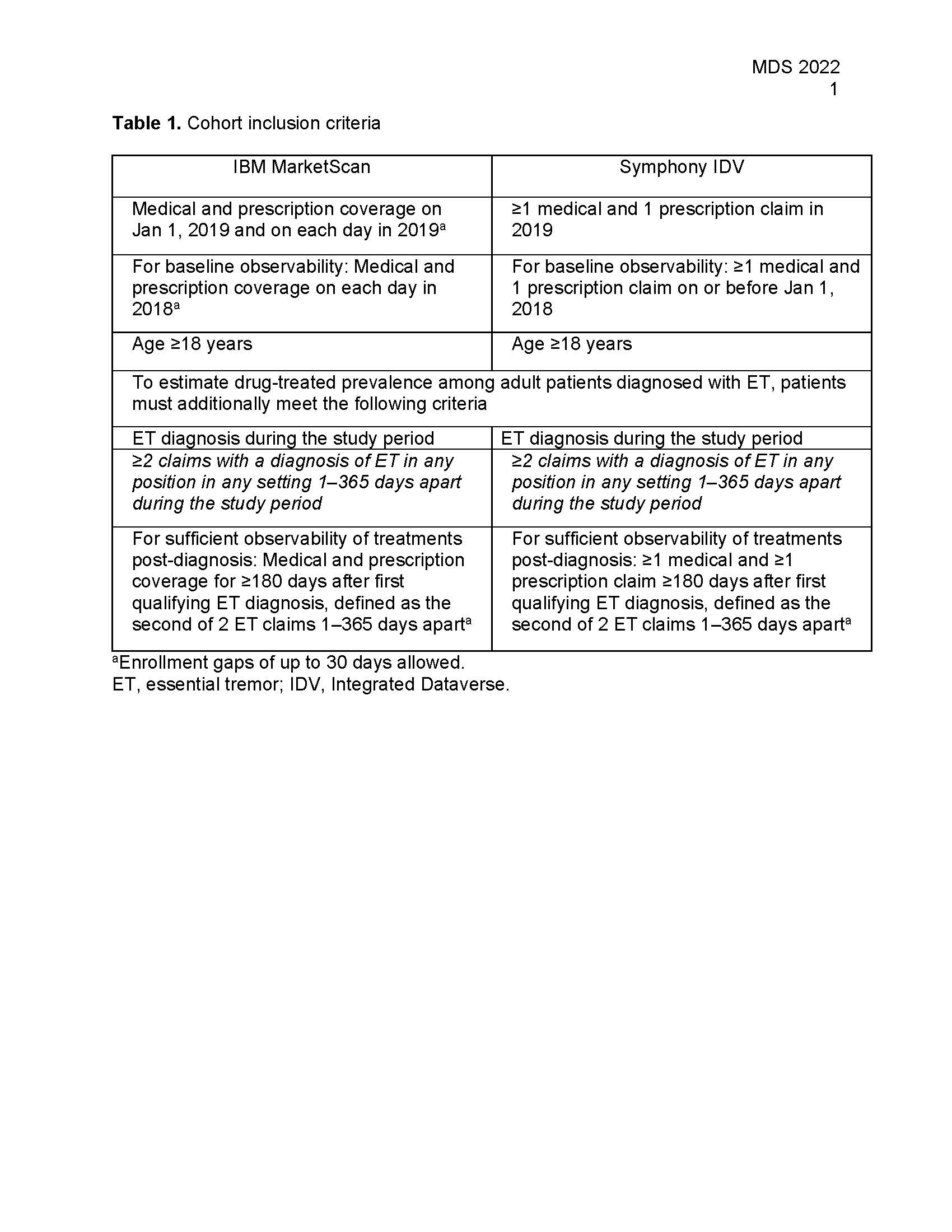Category: Tremor
Objective: Estimate the prevalence of diagnosed and drug-treated essential tremor (ET) in the adult population using 2 US healthcare claims databases.
Background: ET is a chronic, heterogeneous, and progressive tremor disorder characterized by symptoms that can impact activities of daily living[1]. Relatively few epidemiological studies exist describing its diagnosed or drug-treated prevalence in the US.
Method: Two retrospective cohort analyses were conducted using the IBM® MarketScan® (IBM) and Symphony Integrated Dataverse (IDV®) databases (both 01/01/2016–12/31/2019) to estimate the number of US adults (age ≥18 years) with ET. Inclusion criteria are provided in [table 1]. ET diagnosis was defined as 2 medical claims containing ICD-10-CM code G25.0 at least 1 day and ≤365 days apart. Drug-treated patients were defined as prevalent ET patients with ≥180 days of observability following the first ET diagnosis who subsequently received any ET medication in 2019. Age-adjusted (2019 US census data) prevalences were used to estimate the number of US adults diagnosed and drug treated for ET.
Results: The estimated age-adjusted numbers (95% CIs) of patients diagnosed with ET in the US adult population were 782,800 (770,666–795,119) and 525,115 (522,893–527,457) using IBM and IDV, respectively. Among those, the estimated proportions (95% CIs) of adult patients with ET who were drug treated were 73.8% (73.1%–74.4%) and 74.8% (74.6%–75.0%), respectively. The estimated age-adjusted numbers (95% CIs) of patients with drug-treated ET in the US adult population were 588,489 (578,043–599,067) and 391,680 (389,570–393,668), respectively. Beta-blockers (64% and 61% of patients, respectively) and anticonvulsants (53% and 61%, respectively) were the most common drug classes prescribed among treated adult patients. The most frequently prescribed drugs within those 2 classes were propranolol (41% and 35%, respectively) and primidone (27% and 32%, respectively).
Conclusion: To our knowledge, this is the first study to measure ET prevalence in adults using large healthcare claims databases. ET affects a large number of adults in the US and most patients who are diagnosed with ET are also treated. Further research is needed to better understand the prevalence, disease burden, and unmet needs of adult patients with ET.
References: 1. Louis ED, Gerbin M, Galecki M. Essential tremor 10, 20, 30, 40: clinical snapshots of the disease by decade of duration. Eur J Neurol. 2013;20(6):949-54.
To cite this abstract in AMA style:
R. Saad, M. Markowitz, L. Gibbs, D. Fuller, W. Ni, R. Pahwa, K. Lyons, M. Baladi, J. Lin. Diagnosed and Drug-Treated Prevalence of Essential Tremor in Adult Patients: Retrospective Analyses of Two US Healthcare Claims Databases [abstract]. Mov Disord. 2022; 37 (suppl 2). https://www.mdsabstracts.org/abstract/diagnosed-and-drug-treated-prevalence-of-essential-tremor-in-adult-patients-retrospective-analyses-of-two-us-healthcare-claims-databases/. Accessed April 2, 2025.« Back to 2022 International Congress
MDS Abstracts - https://www.mdsabstracts.org/abstract/diagnosed-and-drug-treated-prevalence-of-essential-tremor-in-adult-patients-retrospective-analyses-of-two-us-healthcare-claims-databases/

